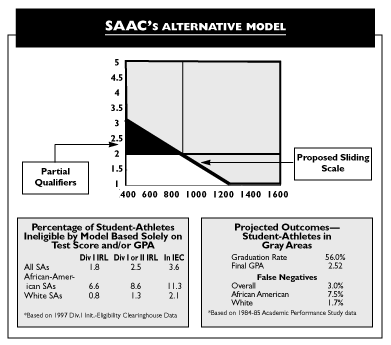The NCAA News - News and Features
The NCAA News -- March 29, 1999
SAAC submits alternative model for eligibility standards
 The Division I Student-Athlete Advisory Committee completed its work on a new initial-eligibility model during its March 13-14 meeting in Kansas City, Missouri. The Division I Student-Athlete Advisory Committee completed its work on a new initial-eligibility model during its March 13-14 meeting in Kansas City, Missouri.
The model, which is consistent with the SAAC's goals of enhancing the total student-athlete experience, provides what the committee believes to be an equally weighted combination of core grade-point average and test (ACT/SAT) score, which has been shown to be the best single predictor of success in college.
The committee submitted the model to the Division I Management Council and the Board of Directors for review. The committee made it clear that the new model, which it had been working on for several months, is not intended as a quick-fix or band-aid solution in light of the federal court ruling against Proposition 16.
"This is meant to be submitted as a long-term solution," said Kerry McCoy, former student-athlete at Pennsylvania State University and chair of the committee. "This model is what the committee believes initial-eligibility standards should be."
The new model presents the full sliding scale without the 2.000 grade-point average cutoff. Nonqualifiers would be able to receive institutional aid, but would not be able to play, practice or travel during their first year. However, nonqualifiers would be able to earn back a fourth year of eligibility after having met continuing-eligibility standards.
The committee believes the model accomplishes the following principles:
Provides more inclusion for all student-athletes and should not have an illegal adverse impact, particularly on minority groups;
Provides all populations equal access to athletics participation;
Prevents any disparate impact on any one group; and
Decreases the false negatives in comparison to Propositions 16 and 48. (A false negative is defined as a percentage of all prospective student-athletes who would be nonquali-fiers under a given rule, yet would be predicted to graduate based on previous research.
"We're not sending a message that athletes need lower standards," said McCoy. "We believe this model helps prospects who were qualifiers under Prop 48 but not under Prop 16 to regain that access."
In addition to the initial-eligibility model, the SAAC also expressed its concern that current continuing-eligibility standards be strengthened to ensure success toward graduation. The committee noted that under the current system, it is possible for fourth-year seniors to have completed only 50 percent of the continuing-eligibility requirements.
The committee also discussed various legislative proposals during its meeting, including Proposal No. 98-54. The proposal, which was not supported by the committee, would expand the spring evaluation period to permit 30 consecutive days and, in Division I-A football, allow one phone call to a prospect during the school's designated spring evaluation period.
The committee also declined to support Proposal No. 98-90, which would permit Division I-AA institutions to schedule a 12th regular-season football contest in those years in which there are 14 Saturdays from the first permissible playing date through the last playing date in November. The proposal already has been adopted for Division I-A.
In addition, the committee will recommend that the Management Council sponsor legislation that would ensure student-athlete representation from all three divisions on Association-wide committees.
|